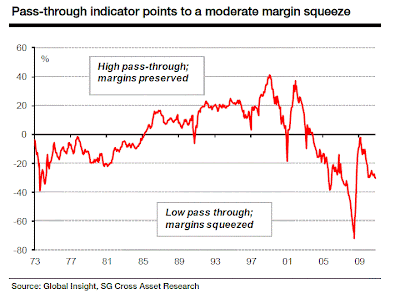About the inflation scare I
reminded as recently as last week, and now it goes mainstream in mass media, while the topic
here was covered a year ago. Even the astute
ECRI gets concerned ... but not the US equity market so far.
About month ago I had the chart about
squeezed German dream. However, the economists at Societe Generale presented their "Pass-Through Indicator" for the US. Click on chart to enlarge, courtesy of Societe Generale.
And the comment was actually quite optimistic:
So far, the commodity rally has been absorbed quite well by the US economy and we do not yet see the commodity price shock as strong enough to derail the recovery. However, it is a growing risk that could start to squeeze profit margins. If prices continue to rise at the current pace, the recovery could be threatened.
Sure, also in the unfortunate case the US administration will find a solution, like another round of fiscal and monetary stimulus for the benefit of bond vigilantes ... so that China can finally collapse and pull the rest of the world into deflationary spiral?






























